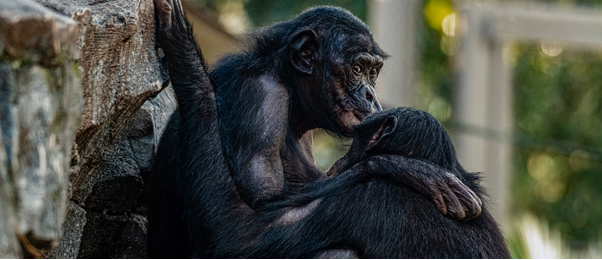Insects: the remedy of choice for mama chimpanzees

Researchers from the Ozouga Chimpanzee Project had been studying the same group of chimpanzees for 7 years. However, it wasn’t until 2019 that Alessandra Mascaro, a volunteer at the project, noticed a never-before-seen behavior.
At Loango National Park (Gabon, West Africa), chimpanzees have been observed using insects on the wounds of themselves and others for the first time, providing further evidence for prosocial behavior in animals – a phenomenon doubted by many. Observing animals in their natural environment can provide great insights to our own cognitive evolution.
Caught on video, Mascaro observed a mother chimp catching an insect and applying it to her son’s wound.
“In the video, you can see that Suzee is first looking at the foot of her son, and then it’s as if she is thinking, ‘What could I do?’ and then she looks up, sees the insect, and catches it for her son,’” Mascaro explains.
After this novel observation, Mascaro and the Ozouga Chimpanzee Project team began monitoring the chimps for similar wound-tending behavior. This wasn’t just a one off, as over the next 15 months, the team saw the chimps display the behavior 76 times.
 Hippos can decipher their friend’s thunderous calls from a stranger’s
Hippos can decipher their friend’s thunderous calls from a stranger’s
Hippos use their vocal calls to maintain the social dynamics between groups, and can identify a stranger’s call and respond accordingly.
Self-medicating has been observed in animals before; however, this is the first time nonhuman animals have been observed self-medicating with insects. In addition, the chimps were also seen to be caring for each other, which the team argue is a clear sign of prosocial behavior.
“This is, for me, especially breathtaking because so many people doubt prosocial abilities in other animals,” comments Simone Pika, a cognitive biologist who worked on the study.
The team are unsure which insects the chimps were using, but they predict that they could have pain-relieving properties.
“Humans use many species of insect as remedies against sickness – there have been studies showing that insects can have antibiotic, antiviral, and anthelmintic functions,” notes Pika.
Next, they want to identify the insects being used, and document who is applying insects to whom.
“Studying great apes in their natural environments is crucial to shed light on our own cognitive evolution,” concludes Tobias Deschner, a primatologist from the team. “We need to still put much more effort into studying and protecting them and also protecting their natural habitats.”